

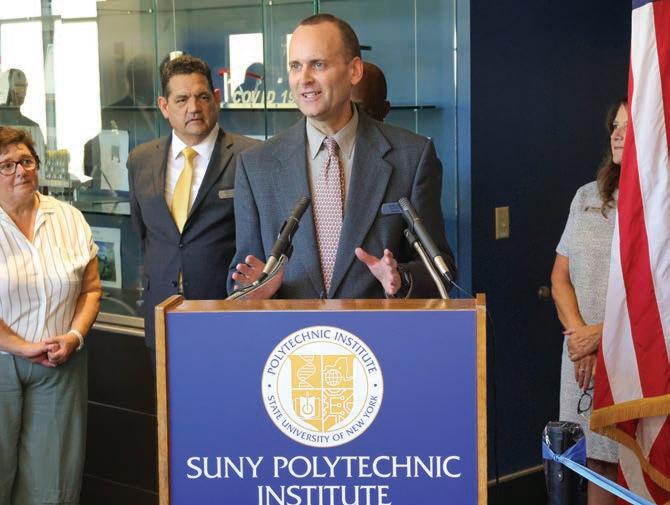
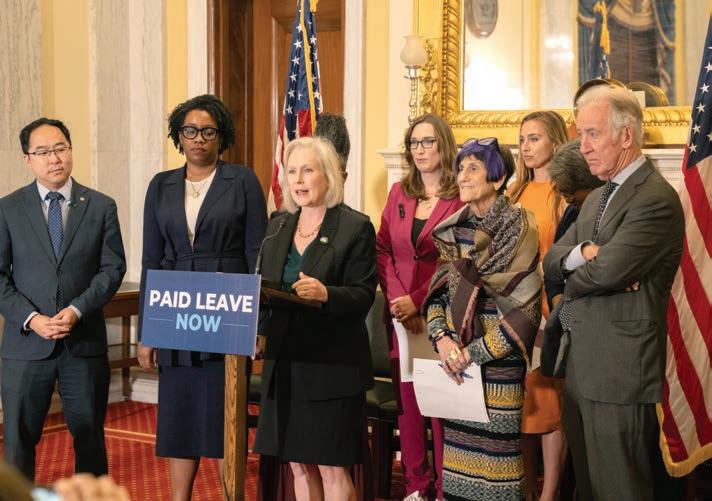









October 20 Special Report: Construction/Sub-Contractors
October 20 List: Commercial Builders & Contractors
October 27 Special Report: Manufacturing Directory
October 27 List: Web-Design Companies
November 3 Special Report: Banking & Credit Union Report
November 3 List: Banks
November 10 Special Report: Resources for Small Business/Education
November 10 List: Chambers of Commerce
November 17 Special Report: Manufacturing/High-Tech/Incubators
November 17 List: Nursing Programs
November 24 Special Report: Employee Benefits/HR/Insurance
November 24 List: Commercial RealEastate Firms
December 8 Special Report: Energy/ Environment/Sustainability
December 8 List: Ski Resorts
December 15 Special Report: Construction/Design/Real Estate
December 15 List: Landscape Architects
December 22 Special Report: Nonprofit Directory
December 29 Special Report: Healthcare Quarterly/Excellence in Healthcare Spotlights NEW!
Mark Muthumbi, Central New York and Southern Tier regional president at Rochester–based Excellus BlueCross BlueShield, speaks at the Sept. 12 formal-opening ceremony of the CNY Liverpool Resource Center at 7421 Oswego Road (Route 57) in the town of Clay.
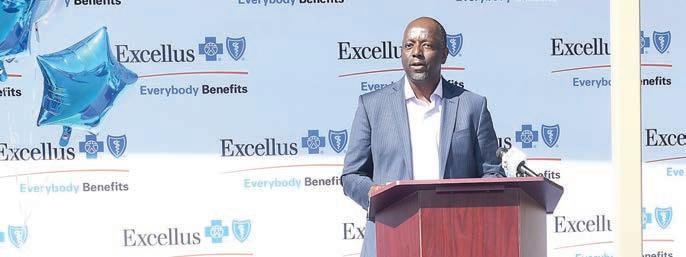
CLAY — Excellus BlueCross BlueShield’s new community resource center is now operating in the Glenn Crossing Plaza at 7421 Oswego Road (Route 57) in the town of Clay.
The Rochester–based health-insurance provider formally opened the CNY Liverpool Resource Center on Sept. 12. The new center is designed to provide personalized, in-person support for individuals and families navigating their health-insurance options, per the Excellus announcement.
The center is open Monday through Friday, 9:00 a.m. to 4:30 p.m. and offers customer support for individuals seeking health-insurance coverage.
Excellus BlueCross BlueShield is Central New York’s largest health insurer.
Retail-sales consultants are available to help with enrollment in Medicare
Advantage plans, Medicare Supplement plans, prescription drug plans, and individual products on or off the NY State of Health Marketplace including qualified health plans, the Essential Plan, Child Health Plus, and Medicaid Managed Care, Excellus said.
Customer-care advocates are also available to help members with claims, billing, benefits, and other questions.
“As a local, nonprofit health plan, we’re committed to being present in the communities we serve,” Mark Muthumbi, Central New York and Southern Tier regional president at Excellus BlueCross BlueShield, said in the announcement. “This new center gives our neighbors a place where they can sit down face-toface with someone who understands their needs and can help them navigate their health coverage options.”
ITHACA — Tompkins Financial Corp. (NYSE: TMP) recently announced that Matthew Tomazin, its executive VP, chief financial officer (CFO), and treasurer, has been appointed to its market-based board serving the Central New York region.
His expertise will help ensure that Tompkins continues to effectively reach its regional clients and deepen its commitment to the communities it serves, the Ithaca–based banking and financial-services company said in the Aug. 18 announcement.
“With an impressive tenure at Tompkins Financial, Matt’s experience as a leader in financial management makes him well-positioned to advise the company in guiding clients toward lasting financial success,” Steve Romaine, president and CEO of Tompkins Financial, said. “We’ve witnessed Matt’s business acumen and thoughtful approach to complex financial issues earn the trust of clients and colleagues alike. His leadership, strategic insight, and commitment to excellence make him an invaluable asset to our team and the Central New York board.”
Appointed as CFO of Tompkins in October
New York egg production drops slightly in August 2025
Farms in New York state produced 149.6 million eggs this August, down 0.4 percent from 150.2 million eggs in the year-prior month, according to a Sept. 22 report from the USDA’s National Agricultural Statistics Service (NASS).
The total number of layers in the state averaged more than 5.93 million in the eighth month of 2025, up 2.75 percent from over 5.77 million layers in August 2024. Egg production per 100 layers fell 3.1 percent to
2,521 eggs this August from 2,601 eggs in the year-ago month. U.S. egg production fell 2 percent to 8.89 billion eggs in August 2025 from almost 9.07 billion eggs in the same month in 2024.

ConMed Corp. (NYSE: CNMD), a surgical-device maker originally based in the Mohawk Valley region, recently announced that Kim Kelderman joined its board of directors, effective Sept. 8.

“My fellow directors and I are delighted to welcome Kim to the board,” LaVerne Council, chair of ConMed’s board, said in the announcement. “Kim brings extensive global leadership experience across life sciences businesses, with a strong track record in innovation and strategy. Kim’s skills and insights will be valuable additions to the board.”
Kelderman has been president, CEO, and member of the board of Bio-Techne Corporation (NASDAQ: TECH) — a global provider of life-science tools, reagents and diagnostic products based in Minneapolis — since February 2024. He first joined BioTechne in April 2018, as president, diagnostics, and genomics, and served as chief operating officer from November 2023 to January 2024. Bio-Techne generated more than $1.2 billion in net sales in fiscal-year 2025 and has about 3,100 employees worldwide.

2023, Tomazin is an expert in bank financial management, with extensive experience in financial modeling, asset and liability (ALCO) management, profitability modeling, governance and controls and strategic planning and execution, the company contends. He is the senior executive responsible for managing the financial performance of Tompkins by providing strategic guidance, overseeing financial operations, and making informed decisions to drive the company’s growth and profitability.
Tomazin is a 2007 graduate of Binghamton University and 2014 graduate of the Darden/SNL Executive Program in Bank Financial Leadership.
Tompkins Financial Corp. serves the Central, Western, and Hudson Valley regions of New York and the Southeastern region of Pennsylvania. It is parent to Tompkins Community Bank, Tompkins Insurance Agencies, Inc., and offers wealth-management services through Tompkins Financial Advisors.
Prior to Bio-Techne, Kelderman worked at Thermo Fisher Scientific, where he led three different businesses of increasing scale and complexity. Kelderman managed the platforms and content of the Genetic Sciences Division, where he was responsible for the Instrumentation, Software, Consumables and Assays businesses, and brands such as Applied Biosystems and legacy Affymetrix. Before joining Thermo Fisher, Kelderman served as senior segment leader at Becton Dickinson, managing the global Blood Tubes “Vacutainer” business. Kelderman holds a bachelor’s degree from Hogeschool Heerlen of Applied Sciences in the Netherlands.
“Kim is an excellent addition to the board,” said Patrick Beyer, president and CEO of ConMed. “We are excited to benefit from his extensive experience and valuable perspective as we pursue our long-term vision and deliver value across our stakeholder community.”
ConMed is a medical technology company that provides devices and equipment for surgical procedures. Surgeons and other healthcare professionals use the firm’s products in a variety of specialties, including orthopedics, general surgery, gynecology, thoracic surgery, and gastroenterology. ConMed reported net sales of $663.6 million in the first six months of 2025, up 3 percent from nearly $644.4 million in the first half of 2024.
Based in Largo, Florida (Tampa Bay area) since 2021, ConMed still operates a facility on French Road in New Hartford, where it was formerly headquartered. The company employs about 3,500 people worldwide.
Dairy farms in New York state produced 1.408 billion pounds of milk this August, up 3.5 percent from 1.361 billion pounds of milk in the yearago month, according to the latest monthly milk-production report that the USDA’s National Agricultural Statistics Service (NASS) issued on Sept. 22.
Milk production per cow in the state averaged 2,200 pounds in the eighth month of 2025, up nearly 1.9 percent from 2,160 pounds in August 2024. The number of milk cows on farms in the Empire State totaled 640,000 head in August 2025, up 1.6 percent from 630,000 in the year-prior month, NASS reported.
Milk production in the nation’s 24 major dairy producing states totaled nearly 18.77 billion pounds in August of this year, up 3.3 percent from more than 18.16 billion pounds in August 2024, according to the USDA.

BY ERIC REINHARDT ereinhardt@cnybj.com
UTICA — Dr. William LeCates, who has been serving as COO of the Mohawk Valley Health System (MVHS) for the past 14 months, will become the system’s top executive on Oct. 20.

The MVHS board of directors on Sept. 18 announced the appointment of LeCates, who will succeed Darlene Stromstad, who is retiring after nearly seven years in her role leading MVHS.
Following Stromstad’s announced retirement, MVHS says its board of directors conducted a national search for a president and CEO and, after extensive interviews with other highly qualified candidates, selected LeCates as Stromstad’s successor.
As COO, LeCates has been responsible
for clinical-support services, operational-support services, supervising MVHS product lines, and working with quality and medical education.
Dr. LeCates has also maintained a limited clinical practice in internal medicine and nephrology, MVHS noted.
“Dr. LeCates is a proven leader with a deep understanding of healthcare systems and an unwavering commitment to patient care,” Richard Zweifel, chair of the MVHS board of directors, said in the MVHS announcement. “His clinical expertise, operational experience and knowledge of the region make him uniquely suited to lead MVHS into its next chapter.”
Stromstad will continue to act as an advisor to MVHS through the end of this year.
“We are grateful to Darlene Stromstad for the key role she played in bringing the Wynn Hospital to fruition,” said Zweifel. “Her leadership and guidance helped to steer the organization both during the
transition to a new facility as well as during a worldwide pandemic.”
LeCates began his career in health care more than 25 years ago. Prior to joining MVHS, LeCates served as an executive director for JPMorgan Chase where he provided clinical oversight of the healthcare operations of 22 U.S. health centers serving more than 150,000 employees.
As a physician and health-care leader, the majority of LeCates’ career has been spent in various roles with Cooperstown–based Bassett Healthcare Network and its affiliates, including serving as president and COO of Bassett Medical Center.
“I’m honored that the Board of Directors has the confidence in me to lead MVHS into its next chapter,” LeCates said. “Working alongside the extraordinary caregivers at MVHS over the past year has been a tremendous privilege.

Innovation Hub is now open for entrepreneurs, the public to see
BY ERIC REINHARDT ereinhardt@cnybj.com
SYRACUSE — The first in a series of monthly openhouse events at the INSPYRE Innovation Hub (the expanded former Tech Garden) is set for Oct. 30 at 11 a.m.
The 90-minute event allows those interested to “explore our startup services and programs and learn how we support entrepreneurs in Central [New York!],” per the events page on the facility’s website. Those interested are asked to register at https://inspyrehub.com/events/
CenterState CEO on Sept. 18 formally opened the expanded INSPYRE Innovation Hub at 235 Harrison St. in Syracuse.
The ribbon cutting followed a two-year, $32 million expansion project. Empire State Development provided up to $16.6 million for the initiative through the region’s CNY Rising Upstate Revitalization Initiative.
The project included a two-story addition to the existing building, renovations to the facility’s
existing space, updates to the on-site mechanical and security systems, a new 5,000-square-foot roof terrace accessible to clients, 3,000-square-foot meeting room, private tenant offices for 35 additional resident startups, coworking areas, an expanded hardware space for prototype and product development and a new entrance.
Hueber-Breuer Construction Co., Inc. served as the contractor on the project. Besides HueberBreuer, Eli Smith of E. Smith Contractors of Syracuse also contributed, and QPK Design of Syracuse handled the design work.
The expanded facility serves to anchor Syracuse’s City Center Innovation Hub, a core component of the Syracuse Surge economic-development strategy and will serve as the gateway to the “Innovation Alley” on Warren Street in Syracuse, the office of Gov. Kathy Hochul said in its Sept. 18 announcement.
The multi-story facility is the largest business incubator in New York State, Hochul’s office added.
INSPYRE will continue to be
the central hub for the Genius NY program, described as the world’s largest business accelerator for the uncrewed systems and robotics industry. Since 2017, Genius NY has invested nearly $24 million in 42 companies from around the world and the companies who have taken part have raised more than $350 million in follow-on funding and created hundreds of new jobs in New York state.
“The building for us and the building for me encapsulates where Syracuse is right now as a community, right?” Ben Sio, acting president of CenterState CEO, said in his remarks to open the event Thursday morning. “We’re on the cusp of something big [not only] as an organization but as a community... This is a 90,000-square-foot facility now. It’s the largest accelerator and incubator in New York State.”
Sio went on to say, “I think what’s more important about this facility is what got us here today. We’ve been working on tech startups and supporting a small-business ecosystem before
Together, we have before us a wonderful opportunity to grow and evolve in bringing the very best quality healthcare to all the communities we serve. I am truly grateful to lead MVHS at this critically important time.”
LeCates earned his undergraduate degree from Amherst College and earned his medical degree from the Johns Hopkins University School of Medicine, MVHS said. He completed his internal-medicine residency and nephrology-fellowship training at the Johns Hopkins Hospital. LeCates is board certified in internal medicine and nephrology.
LeCates also brings many years of military-leadership experience to the CEO role. He currently serves as a colonel in the New York Army National Guard, with previous overseas tours in Afghanistan, Iraq, and Liberia. LeCates is a graduate of the United States Army War College in Carlisle, Pennsylvania. n

CenterState was a thing. For over 20 years, our organizations have focused on investing in the smallest of small businesses and helping make sure that they’re successful, and we’ve been really successful in doing that.”
Sio also acknowledged the attendance of former U.S. Representative Jim Walsh, who is also the father of current Syracuse Mayor Ben Walsh. Just over two decades ago, as chair of the House Appropriations Committee, Jim Walsh secured some of the initial funding to renovate the original facility from a collapsed parking garage into what was the Tech Garden.
“Your vision helped us get here today. Thank you,” Sio said to Walsh, a comment that was greeted with applause.
Besides Sio, those speaking at the event included New York State Senator Rachel May (D–Syracuse); New York State Assemblyman Al Stirpe (D–Cicero); New York State Senator Chris Ryan (D–Geddes); Syracuse Mayor Ben Walsh; Onondaga County Executive Ryan McMahon; Katie Newcombe, director of economic development for New York at National Grid; John Liddy,
VP of innovation and entrepreneurship at CenterState CEO; and Steve Gorczynski, Central New York regional president for Buffalo–based M&T Bank (NYSE: MTB), which on Sept. 9 said it signed a seven-year deal with CenterState CEO to serve as the founding sponsor of the INSPYRE Innovation Hub. In his remarks, Stirpe recalled Robert Simpson, president and CEO of CenterState CEO, telling him about the expansion idea in 2017 and seeing the facility’s design about a year later. A few years later, Simpson notified Stirpe that the renovation would cost about $32 million, up from the initial figure of $24 million. Stirpe then noted that it took some work, but Syracuse–area state lawmakers were able to secure the funding.
Stirpe went on to say he’s a big believer in the “pursuit of wow!”
“Why have something that’s just like everybody else’s? You want to have something that … you don’t even need a sign on the front,” Stirpe said. “When people drive around, they say, where’s the Innovation Hub? All they have to do is look up, and they’ll know that’s this building, and that’s what I’m most proud of.” n
BY ERIC REINHARDT ereinhardt@cnybj.com
SYRACUSE — The Syracuse Northeast Community Center (SNCC) will use an additional $25,000 grant from Spectrum to further enhance its workforce-development program.
The funding comes through the Spectrum Community Center Assist (SCCA) initiative.
It’s part of Spectrum’s $30 million philanthropic initiative to revitalize local community centers and invest in job-training programs in rural and urban underserved communities where the telecommunications and mass media company operates.
“We are only able to do the crucial work of connecting neighbors with opportunity through generous support such as Spectrum provides. Their devotion to
workforce development and support of our community has been incredible,” Brian Fay, executive director of the Syracuse Northeast Community Center, said in the announcement.
Spectrum says it launched the partnership on Oct. 7, 2023, with employees and community volunteers making repairs and other physical improvements to the Syracuse Northeast Community Center.
As part of the initiative, Spectrum donated 25 new laptops for a new technology room and provided $50,000 to support the organization’s workforce-development program. Additionally, Spectrum offered its 1 Gig service at no charge for the life of the program and donated an additional set of 25 new laptops to further support the center’s training and technology programs.
The Syracuse Northeast Community
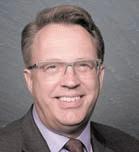
AJOHN C. WILLIAMS Viewpoint
key lesson of the past 20 years is to expect the unexpected. Over that period, we’ve faced the global financial crisis, the euro crisis, the long period of zero or even negative interest rates, the COVID-19 pandemic, Russia’s war on Ukraine, and most recently, seismic shifts in the global trade and geopolitical environment.
Unpredictable change and uncertainty will certainly continue to be with us for the foreseeable future. Consider, for example, the effects of ongoing global demographic shifts, artificial intelligence (AI), and potentially transformative innovations in our financial systems.
If history teaches us to expect the unexpected, then what does that mean for monetary policy? First and foremost, it underscores the need for principles and strategies that provide the foundation for decision-making across a wide range of circumstances. This does not mean a playbook for every conceivable situation — that is doomed to fail. Instead, it is a consistent overarching strategy that shapes and informs decision-making. Second, it means having the ability and readiness to act as needed for any situation that arises. Third, it implies being clear-eyed and disciplined in adapting to and communicating the changing economic landscape and resulting policy trade-offs and decisions. It’s important to be nimble in execution even as one is steady in strategy.
I am happy to say that all three of these features are foundational to the recent reviews of monetary policy frameworks conducted by the European Central Bank (ECB) and the Federal Reserve (Fed), as well as policy frameworks used by many other central banks.
So far, I have stayed at a high level. I will now get into some specifics of how these observations translate into real-world practice. I will organize this discussion across

Center serves more than 7,500 individuals annually. Through the partnership, the center has provided 1,386 people with job training, assisted 47 individuals in obtaining credentials, and enabled 239 people to secure meaningful employment and connect with other essential services. Since the partnership began, Spectrum has committed a total of $125,000 in grant funding and more than $50,000 in revitalization funding to support these initiatives. n
three broad categories, corresponding to three key principles of successful monetary policy: accountability, transparency, and well-anchored inflation expectations.
I will start with accountability: Central banks must own the responsibility to deliver price stability and have the independence of action and the ability to achieve it.
In the distant past, many central bankers believed that monetary policy could only play a minor role in reducing inflation, while others thought that inflation was completely outside of their control. The result was persistently high inflation and economic stagnation. History has taught us that central banks can be more successful at delivering sustainably low inflation when they are accountable for their decisions and can act independently. Today, central bankers around the world recognize that attaining and maintaining price stability is their job to do.
But it is not enough to be accountable and independent: central banks must have the appropriate tools to carry out their mandates. Outside of the hallways of central banks, monetary policy is commonly understood through the overly narrow lens of setting the current short-term interest rate. All the attention is on what the ECB, the Fed, or another central bank will “do” at its next policy meeting.
Of course, this focus is not entirely surprising since central banks generally use the shor t-term interest rate as the primary policy instrument. And the academic literature, including the Taylor Rule and all its variants, has reinforced this notion that equates monetary policy to setting of the short-term rate. Indeed, there even has been a label attached to it: “conventional monetary policy.” By implication, other monetary policy actions that have been used — such as for ward guidance and balance sheet policies — are deemed “unconventional,” and therefore somewhat suspect. However, this narrow understanding of monetary policy is alien to the history of monetary economics and central bank practice. A reading of Milton Friedman
and Anna Schwartz’s pathbreaking history of the Federal Reserve during the Great Depression dispels the notion that monetary policy is limited to setting the short-term rate and instead emphasizes broader measures of liquidity and longer-term interest rates. The same is true for Alan Meltzer’s detailed history of the Federal Reserve.
In this regard, I am reminded of Ben Bernanke’s speech from 2002, titled “On Milton Friedman’s Ninetieth Birthday.” In it, Bernanke provided a clear and succinct overview of the Friedman and Schwartz critique of Federal Reserve policy during the Great Depression. Of particular note is the example of the spring of 1932, when the Fed briefly engaged in open-market purchases to support broad liquidity, which was beginning to have an effect on the economy. But this policy was soon abandoned, as the Fed reverted to the view that the low level of nominal interest rates indicated an expansionary monetary policy. Ben famously finished the speech by acknowledging these mistakes. And he promised not to repeat them — a vow he would soon uphold through leading the Fed’s actions during the global financial crisis.
Around the same time, and well before “unconventional” policies had that name, monetary economists from different schools of thought — including Ben McCallum, Athanasios Orphanides and Volker Wieland, Gauti Eggertsson and Mike Woodford, Ben Bernanke and Vicent Reinhart, Alan Auerbach and Maury Obstfeld, and my own work with Dave Reifschneider — described how monetary policy could be effective even in situations where nominal short-term rates were very low. These are not “emergency,” “crisis,” or “break-the-glass” policies, but those that are well within the long tradition of monetary theory and practice. Of course, how and when to use policies depends on the circumstances and the risks policymakers are facing. But this is a matter of tactics and implementation, not of principle or strategy.
The second principle is transparency — including the clear communication of a central bank’s framework, an explicit numerical longer-run inflation target, and the reasoning behind policy decisions.
For central banks, transparency enhances accountability and keeps them clearly focused on achieving their goals. For households and businesses, an explicit and credible inflation target helps take some of the uncertainty off the table so they can focus on planning for their future. By improving the public’s understanding of a central bank’s goals and actions, the central bank can enhance the effectiveness of monetary policy at stabilizing inflation and the economy. Based on a foundation of clear goals and strategy, central banks are better able to communicate their thinking behind policy decisions and how they relate to policy goals.
This is often done through economic forecasts, reports, and speeches. Transparency around the factors that influence policy decisions can, in turn, improve the public’s understanding of the policy reaction function, thereby enhancing the effectiveness of policy. Indeed, many central banks have increasingly provided detailed macroeconomic analyses of factors relevant for monetary policy, including staff or policymaker estimates of the output gap and the natural rate of interest.
There is no single best way to achieve transparency — this is not one size fits all. Instead, the approach must conform to the institutional structures and practical realities of each jurisdiction. The Monetary Policy Reports of the Riksbank and Norges Bank, to name two examples, provide very clear summaries of the views of their policy committees, including their assessments of the distribution of the path of future interest rates. In contrast, central banks with large committees or a mix of internal and external members have not done so. Such differences across central banks may be more a feature than a bug: One of the benefits of greater transparency and the variety of different practices is that we can all learn from each other’s experiences as we strive to further improve communications consistent with our institutional structures and needs.
The third key principle of successful monetary policy is well-anchored inflation
BY ERIC REINHARDT ereinhardt@cnybj.com
MARCY — SUNY Polytechnic Institute (SUNY Poly) has appointed Jim Staihar, assistant professor of business ethics, as the inaugural executive director of its NYSTEC Business Center of Excellence.
SUNY Poly formally opened the NYSTEC Business Center of Excellence during a ceremony held on Sept. 19.
“I am deeply honored to be named Executive Director of the NYSTEC Business Center of Excellence,” Staihar said in the Sept. 25 announcement of his appointment. “This center represents a unique opportunity for our students to explore artificial intelligence, confront the ethical challenges of modern business, and pursue bold entrepreneurial ideas. I am excited to work alongside our faculty, staff, and community partners to create an environment where students can develop the skills, knowledge, and integrity needed to lead in today’s dynamic global economy.”
In addition to his new leadership role, Staihar serves as assistant professor of business ethics in SUNY Poly’s College of Business. He was previously the inaugural Fishlinger Family Endowed Scholar at the University of Maryland’s Center for the Study of Business Ethics, Regulation,
and Crime and has held fellowships at Princeton University and the University of Chicago Law School.
A $500,000 pledge from New York State Technology Enterprise Corporation (NYSTEC) sparked the initiative to support the creation of an interdisciplinary business center in SUNY Poly’s Donovan Hall. To acknowledge the donation, the new hub will bear the name NYSTEC Business Center of Excellence.
The NYSTEC Business Center of Excellence will serve as a vital hub for innovation, entrepreneurship, and interdisciplinary education, SUNY Poly said in its announcement.
It includes an AI & Business Lab, which exploring the “transformative” impact of artificial intelligence (AI) on business, along with a business-ethics initiative, which offers programs and events to address the “moral complexities” of modern business.
The center also includes an entrepreneurship and innovation hub that provides support for student startups, mentorship, and networking opportunities. It also has an AI trading room, which is described as an environment for students to engage with real-world financial-market simulations.
“We are deeply grateful to NYSTEC and
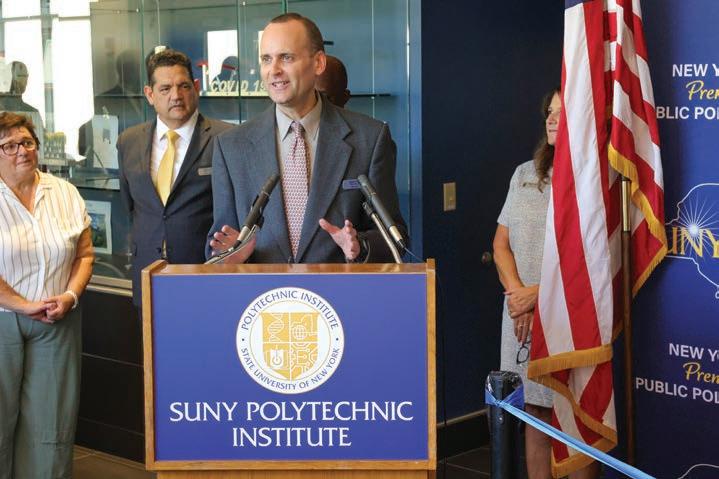
our many donors for making this Center possible,” SUNY Poly President Winston Soboyejo said. “Their generosity is an investment in our students — the innovators, entrepreneurs, and leaders of tomorrow. The NYSTEC Business Center of Excellence is more than a building; it is a hub where students will explore artificial intelligence, engage with the ethical challenges of business, and bring bold ideas to life. Together, we are creating opportunities that will prepare SUNY Poly graduates to succeed in a rapidly changing global marketplace.”
The ribbon-cutting event brought together elected officials and leadership from Oneida County, the City of Utica, the New York State Legislature, and members
of Congress, alongside campus leaders, faculty, staff, and students.
“We are proud to support the launch of the NYSTEC Business Center at SUNY Poly, which reflects our mission to strengthen communities and prepare the workforce of tomorrow,” NYSTEC CEO Kevin Owens said. “The center will be an important resource for the Mohawk Valley, driving economic development and creating new opportunities for students and businesses alike. Students will be exploring some of the most important and pressing technological and business issues of our time. This investment highlights our deep partnership with SUNY Poly and our shared commitment to the region’s growth.” n







additional information, please visit:


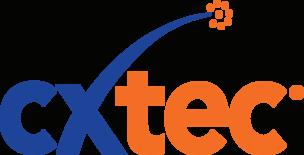



BY ERIC REINHARDT ereinhardt@cnybj.com
UTICA — Utica will host the 2026 New York State Tourism Conference, presented by the New York State Tourism Industry Association (NYSTIA).
The event is set for April 22-24, 2026 at Delta Hotels by Marriott Utica, located at 200 Genesee St. in downtown Utica. It will welcome more than 200 tourism professionals from across New York state to the Mohawk Valley, Oneida County Tourism (OCT) announced.
OCT says Utica’s growing hospitality infrastructure, central location in the state, and recent investments all played a role in the selection, per the Sept. 18 announcement.
“From Turning Stone Resort Casino’s Evolution expansion in Verona to the Utica University Nexus Center, a thriving food and beverage scene, and rising recognition of the area’s arts and heritage, the city continues to be an increasingly attractive hub for events of all kinds,” OCT contends in its announcement.
Madison Cermak, director of operations at Oneida County Tourism, is leading the effort to bring the conference to Utica, alongside OCT President Sarah Foster Calero and the NYSTIA executive team.
The event is expected to generate more than 250 hotel room nights and an estimated $75,000 in direct spending at local restaurants, coffee shops, and businesses.
“Hosting the 2026 New York State Tourism Conference is an incredible honor for Oneida County Tourism and for our community,” Calero, who is also a board member of NYSTIA, said in the announcement. “I’ve attended this conference in other parts of New York, and now it’s our turn. For me, this is about more than welcoming colleagues from across the state — it’s our chance to give attendees a taste of what makes us special, and I’m not just talking about chicken riggies and halfmoons. We’re excited to create a conference experience that delivers tremendous value while giving everyone a true sense of place here in CNY.”
“We’re so excited to welcome the New

York State Tourism industry to the Delta Marriott Utica,” Lee Arthur, general manager at Delta Hotels by Marriott Utica, said. “We are looking forward to showcasing not only our hotel, but also Oneida County and all the exciting things happening around the city.”
Conference programming will include keynote presentations, breakout sessions, and networking opportunities, along with off-site learning classrooms and immersion tours at attractions across the county.
“Oneida County is proud to host the NYSTIA Conference and to showcase all that our region has to offer,” Oneida County Executive Anthony Picente, Jr. said. “From our rich history and cultural attractions to our natural beauty and growing hospitality industry, this gathering provides an incredible opportunity to highlight why Oneida County is such a unique and welcoming destination for visitors from across New York State and beyond.” n


BY ERIC REINHARDT ereinhardt@cnybj.com
The proposed Family and Medical Insurance Leave (FAMILY) Act, sponsored by Senator Kirsten Gillibrand (D–N.Y.) and other Democrats in Congress, would guarantee up to 12 weeks of partial income for workers who need to take leave for serious medical and family events.
Paid medical and family leave is “especially helpful” for new parents and older Americans, who are more likely to have health issues or caregiving obligations for older relatives, per Gillibrand.
Both Gillibrand and U.S. Representative Rosa DeLauro (D–Conn.) on Sept. 16 held a press conference to announce the introduction of the proposed FAMILY Act.
“Without universal paid leave, millions of Americans are forced to make devastating choices between their livelihood and the health of themselves or their families,” Gillibrand said in the
announcement. “By guaranteeing up to 12 weeks of paid leave for workers who have to take time off for a major life event, the FAMILY Act will end these impossible decisions. I am proud to have led the fight for paid leave alongside Representative DeLauro for over a decade, and I’ll continue fighting for this program for as long as it takes so we can give every worker the flexibility and dignity they deserve.”
Gillibrand also introduced the FAMILY Act in the Senate in May 2023 and February 2021, when Democrats controlled the Senate, and the legislation did not advance past committee, according to the website of Congress. gov. Republicans currently have the majority in the Senate. The legislation was first introduced as a bill sponsored by DeLauro in the House back in December 2013, per the website.
Gillibrand and DeLauro today argue the FAMILY Act delivers a “key solution to the country’s public health and economic challenges and is modeled on successful state programs,” Gillibrand’s
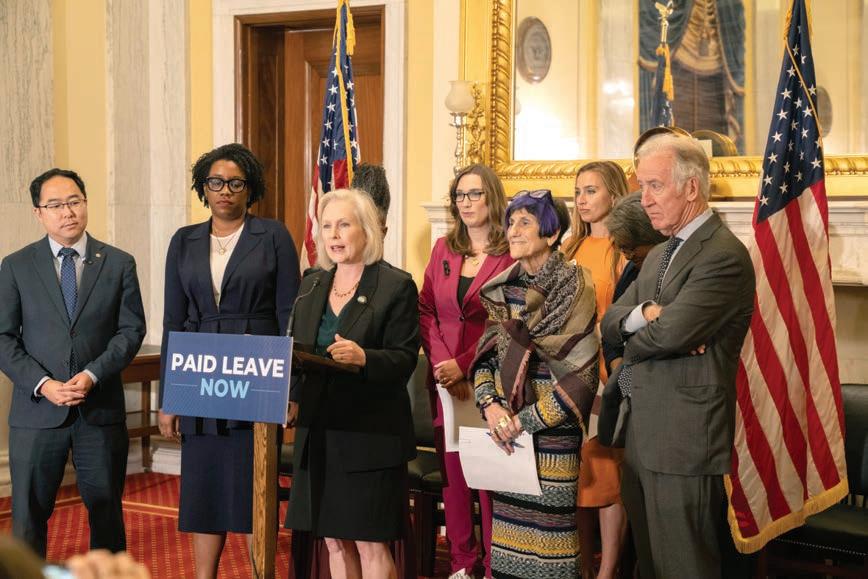
office said. Currently, 73 percent of American workers do not have access to paid leave despite a large body of research showing that paid leave improves workers’ mental health; boosts employee retention and productivity; and helps businesses. Additionally, working families lose $22.5 billion per year in wages due to a lack of paid family and medical leave.
The proposed FAMILY Act would provide workers with paid
Sentencing set for late November
BY ERIC REINHARDT
ereinhardt@cnybj.com
DURHAMVILLE — Sentencing is set for Nov. 21 for the former treasurer of the Durhamville Fire Department in Oneida County, who recently pled guilty to stealing more than $92,000 from the fire department over a seven-year period.
As part of the plea, Kimberly Simchik, 62, of Durhamville will pay restitution of just over $92,000 and faces one to three years in jail at sentencing.
Simchik pled guilty to grand larceny in the second degree and corrupting the government in the second degree before Judge Michael Nolan in Oneida County Court.
New York State Comptroller Thomas DiNapoli, Oneida County District Attorney Todd Carville, and New York State Police Superintendent Steven James announced Simchik’s guilty plea on Sept. 24.
“Kimberly Simchik diverted fire de-
partment resources to bankroll her personal life, betraying the trust of the community she served,” DiNapoli said in the announcement. “My thanks to Oneida County District Attorney Carville and the New York State Police for their partnership in holding her accountable.”
DiNapoli’s office explained that Simchik stole over $90,000 in fire department funds by using the department’s debit card to make payments at local casinos and by diverting checks made out to the department into her personal account. She also spent department funds on plane tickets, spas, and nail salons.
The theft was discovered when a fire department member attempted to make a deposit and was informed by the bank that the department account had been closed due to a negative balance. The fire department subsequently reached out to the New York State Police, who partnered with DiNapoli’s office to conduct an investigation and forensic analysis. Simchik has since resigned from the fire department.
“The Oneida County District Attorney’s Office would like to thank the New York State Police and the New York State
leave for a range of major life events. They include recovering from their own serious health condition; caring for a family member with a serious health condition; and bonding with a new child — whether newborn, adopted, or placed through foster care.
The life events could also include handling responsibilities related to a family member’s military deployment; and taking
“safe leave” to respond to domestic violence, sexual assault, or stalking.
Gillibrand and DeLauro were joined at the press conference by Senators Ron Wyden (D–Ore.) and Andy Kim (D–N.J.), as well as Reps. Richie Neal (D–Mass.), Lauren Underwood (D–Ill.), and Sarah McBride (D–Del.). The proposed legislation is also cosponsored by a number of other Democrat senators. n
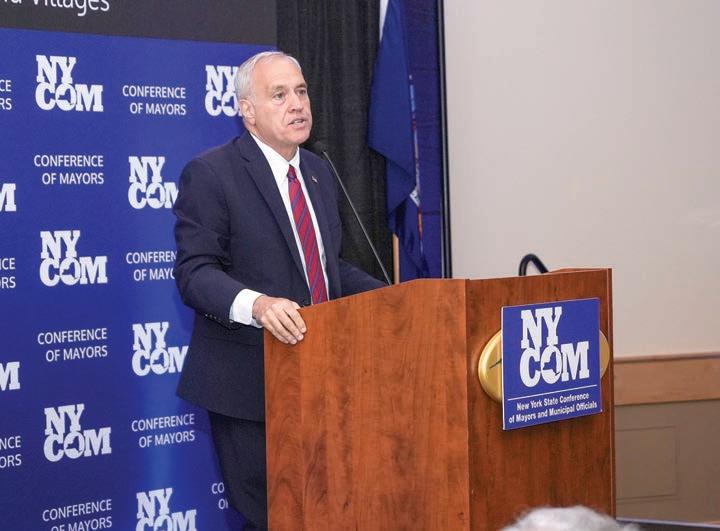
Comptroller’s Office for their assistance in bringing the defendant to justice,” Carville said in the DiNapoli announcement. “This reprehensible act has no place in our society. Stealing from our volunteer service, the great men and women who dedicate
their time and talent to the Durhamville Fire Department, is wholly unacceptable and inexcusable. I would like to thank my Assistant, Assistant District Attorney Kurt Schultz, for holding Ms. Simchik accountable for her actions.” n
BY ERIC REINHARDT ereinhardt@cnybj.com
SYRACUSE — Barclay Damon, LLP says it has a multidisciplinary group of attorneys providing legal services across the pharmacy, pharmaceutical, and health-innovation industries.
Its national pharmacy team builds on decades of experience advising retail, specialty, compounding, infusion, long-term care, and 340B pharmacies as well as wholesalers, manufacturers, investors, and startups into a nationally focused, industry-specific practice, the Syracuse–based law firm said in a Sept. 9 announcement.

“We’ve advised pharmacy clients through every stage of growth and challenge,” Linda Clark, co-chair of the law firm’s pharmacy team, said in the announcement. “This launch reflects Barclay Damon’s commitment to delivering coordinated, industry-specific counsel that helps our clients stay compliant, protect their businesses, and seize opportunities in a complex regulatory and contractual environment.”
This group of attorneys has experience in key practice areas that include regulatory compliance and PBM enrollment, audits, investigations, and terminations.
The practice areas also include government investigations and enforcement defense; licensing and operational strategy; corporate transactions, investments, and rollups; data security, HIPAA compliance, and digital health; intellectual property, trademarks, and tech licensing; employment, workforce strategy, and tax planning; and real estate and pharmacy-site development.

“Our attorneys don’t just know the law, we understand how pharmacy businesses actually operate,” Brad Gallagher, pharmacy team co-chair, said. “Whether we’re advising a startup or defending a multistate provider, our focus is always on delivering clarity, minimizing risk, and driving results.”
The pharmacy attorneys provide legal counsel to individuals and entities across the entire supply chain. That includes retail, specialty, compounding, infusion, long-term care, and 340B pharmacies; pharmacy owners, executives, and licensed pharmacists; and wholesalers, distributors, and pharmaceutical manufacturers.
They also provide legal counsel for private-equity firms and other strategic investors; health-care startups, digital health companies, and technology innovators;

and consultants, vendors, and service providers supporting the pharmacy sector, the firm said.
The pharmacy attorneys will deal with representative matters that include recovering reimbursements and reversing PBM (pharmacy benefit manager) terminations and enrollment denials, including through litigation and emergency injunctions.
They’ll also defend clients in complex federal and state audits and investigations, including those led by the U.S. Department of Justice (DOJ); Drug Enforcement Agency (DEA); Office of
DEAR RUSTY: I will turn 65 [soon] and my husband is age 72 (he retired in 2019 at age 66). I would like to retire and enjoy some time with him before he gets too much older. I do not want to have my Social Security (SS) benefits reduced by retiring earlier, but I don’t see a way to be able to accomplish that. My SS benefit will be $1,343 at my full retirement age (FRA). If I took half his retirement when he retired, it would be less than mine. If I take early retirement and he passes away before me, would I get his full benefit as his survivor, or will it be cut? We are trying to figure this out. His current benefit (before Medicare Part B) is $2,978. It’s very confusing.
Signed:ConfusedandWondering
Dear Confused: Whenever any Social Security benefit is claimed earlier than full retirement age, the monthly amount is permanently reduced. If you were to retire at age 65, your Social Security benefit would be reduced by about 13 percent — in other words, if your FRA (age 67) amount is $1,343, at age 65 you would get about $1,164. And at age 66 you would receive about $1,253 per month. Whether you would be entitled to a “spousal boost” from your husband depends on how your FRA amount compares to 50 percent of his FRA entitlement. If your FRA amount is less than 50 percent of his

FRA amount, then you would get a “spousal boost,” but the amount of that boost would also be reduced if you claim before your FRA. (Note: from the numbers you provided, you may be entitled to a spousal boost and, if so, it would be applied by Social Security when you claim).
Also, FYI, if you take SS before your FRA and are still working, the Social Security Administration (SSA) has an annual earnings test that limits how much you can earn while collecting early benefits. If you earn more than $23,400 in 2025, you will likely not get all of your monthly SS payments (the SSA will take away some
monthly benefits if you exceed the earnings limit). Of course, if you retire from working, this will not be a problem, because earnings before you claim SS won’t count toward the limit.
When you claim your SS retirement benefit now will not affect your survivor benefit from your husband later. If your husband dies first, your benefit as a surviving spouse would be based on the amount your husband was receiving at his death. But if you were to claim your widow’s benefit prior to your FRA, your survivor benefit would also be reduced (the amount of reduction depends on how
the Inspector General, and Office of the Medicaid Inspector General.
The attor neys can additionally advise startups and innovators on tech licensing, HIPAA compliance, funding, and go-tomarket strategies.
With about 300 attorneys, Barclay Damon describes itself as a regional law firm that operates New York offices in Syracuse (headquarters), Albany, Buffalo. Rochester, and New York City; along with New Haven, Connecticut; Boston, Massachusetts; Washington, D.C.; and Toronto, Ontario. n

much before your FRA you claim your survivor benefit). If you claim your widow’s benefit at or after you FRA, you will get 100 percent of the amount your husband was receiving at his death (instead of your own smaller amount). It will only be reduced if you claim before your full retirement age. n
Russell Gloor is a national Social Security advisor at the AMAC Foundation, the nonprofit arm of the Association of Mature American Citizens (AMAC). The 2.4-million-member AMAC says it is a senior advocacy organization. Send your questions to: ssadvisor@amacfoundation.org.
Author’s note: This article is intended for information purposes only and does not represent legal or financial guidance. It presents the opinions and interpretations of the AMAC Foundation’s staff, trained, and accredited by the National Social Security Association (NSSA). The NSSA and the AMAC Foundation and its staff are not affiliated with or endorsed by the Social Security Administration (SSA) or any other governmental entity.
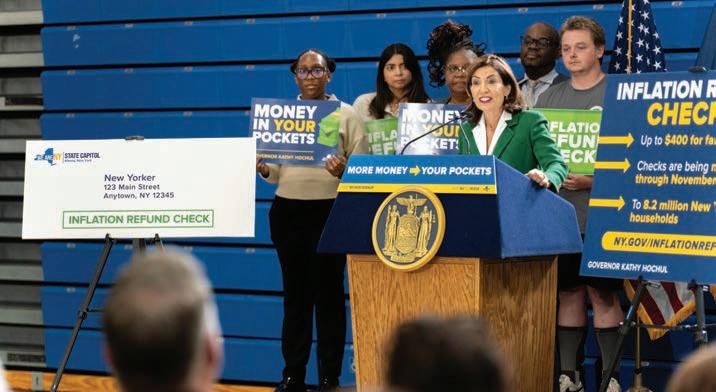
BY ERIC REINHARDT ereinhardt@cnybj.com
ALBANY — Inflation-refund checks of up to $400 are coming to 8.2 million households across New York.
The process started Sept. 26, and the state is mailing checks directly to eligible New Yorkers, with deliveries to continue throughout October and November, Gov. Kathy Hochul announced that day.
Residents don’t need to apply, sign up, or do anything to receive a check.
“Starting today, we’re sending inflation refund checks to over 8 million New Yorkers because it’s simple — this is your money and we’re putting it back in your pockets,” Hochul said in the announcement.
On Sept. 28, Hochul’s office also warned New York residents to be aware of scams related to the inflation-refund checks.
The governor warned New Yorkers of scammers who are sending text messages, voice messages, emails, and direct mail to taxpayers in an attempt to spread false information about the checks.
The messages falsely claim that New Yorkers must submit accurate payment
information in order to receive an inflation-refund check, supposedly so revenue agencies can deposit money into a taxpayer’s bank account. The New York State Department of Taxation and Finance and the IRS will not call or text New Yorkers with requests for any personal information.
You are eligible for an inflation refund check if, for tax year 2023, you filed form IT-201, the New York State resident income tax return; reported income within the qualifying thresholds below; and were not claimed as a dependent on another taxpayer’s return.
Joint tax filers with income up to $150,000 will receive a $400 check, and joint tax filers with income over $150,000 but no greater than $300,000 will receive a $300 check.
Single tax filers with income up to $75,000 will receive a $200 check, and single tax filers with incomes over $75,000 but no greater than $150,000 will receive a $150 check.
The state didn’t place any age restrictions on this process. If you filed a tax return, are below the income thresholds, and no one else claimed you as a dependent, you will receive a check, Hochul’s office said. n
BY JOURNAL STAFF news@cnybj.com
HERKIMER — Herkimer County Community College recently announced it has appointed Michael J. Jory, of Herkimer, as its director of campus safety.

Jory has served as chief of police at the Herkimer Police Department since January 2017. In this role, he was responsible for overseeing all police operations, personnel, and resources, setting departmental policies, ensuring public safety, managing budgets, ensuring compliance with laws and regulations to maintain effective and ethical policing,

Brian J. Potter, CPA, Tax Partner and Chief Operating Officer Dannible & McKee, LLP
Since officially becoming law on Independence Day 2025, the One Big Beautiful Bill Act (OBBBA) has led to significant changes in both individual and business taxes. For businesses with employees who receive tips and/or overtime pay, there are some especially important changes to be aware of.
In addition to the many tax implications of the OBBBA, individuals with dependents should also be aware of so-called “Trump accounts” made available under the new law, which are designed to encourage early investment for children and young adults alike.
Deductions for Tips and Overtime Pay
One of the most notable changes initiated by the OBBBA relates to the taxation of both tips and overtime pay. Specifically, under the OBBBA (and effective retroactively to January 1, 2025), tipped employees can deduct up to $25,000 of qualified tips. However, it is worth noting that this cap is further reduced by $100 for each $1,000 that the individual’s adjusted gross income (AGI) exceeds $150,000 (for single filers) or $300,000 (for joint returns).
Likewise, there are strict qualification requirements in place for tips that can be counted toward this deduction. More specifically, these tips must be:
• Paid in cash, credit card or another tipsharing arrangement.
• Received in an occupation where workers “customarily and regularly” receive tips, such as the food/beverage and beauty industries.
Likewise, the OBBBA has retroactively initiated a tax deduction for workers receiving qualified overtime pay. Under this new provision, workers may deduct up to $12,500 (or $25,000 for joint filers) of overtime pay, with the allowable deduction reduced by $100 for each $1,000 that the employee’s AGI exceeds $150,000 (filing individually) or $300,000 (filing jointly).
What kinds of overtime compensation qualify for this tax break? Under the OBBBA, only the premium portion of overtime as outlined under the Fair Labor Standards Act (FLSA) can be claimed.
Deductions for qualified tips and overtime pay will be effective through at least December 31, 2028. For taxpayers who qualify for these benefits, the deductions can significantly reduce their total tax burden.
What About “Trump Accounts” for Eligible Children?
Instead, taxation only occurs when the funds are distributed (after the beneficiary turns 18).
Why does this matter for employers?
Because under the OBBBA, employers are permitted to make tax-free contributions of up to $2,500 to employees’ Trump accounts. Meanwhile, the OBBBA has also created a so-called pilot program that provides up to $1,000 in contributions for children with a Social Security number who are born between 2025 and 2028.
For employers with tipped workers and/ or workers who receive overtime pay, it’s important to ensure that pay is properly documented and reported for tax purposes, especially with these new provisions in place. For workers opening Trump accounts, this may also be a good time to consider making contributions as a means of taking advantage of the tax benefits while supporting workers.
For individuals receiving overtime/tipped pay and/or those with dependents, it’s important to consider how these provisions might affect you. Specifically, be sure to keep detailed documentation on your tipped and overtime pay so that you can properly claim any eligible deductions come tax time. If you wish to take advantage of taxfree investment in a Trump account for a dependent, now could also be a good time to look into opening an account. If you have a child who was born this year or have one due in the coming year, you may also want to see if you could qualify for the $1,000 Trump account bonus.
Get Help Understanding What OBBBA Could Mean for You
With such a sweeping bill containing so many different provisions, figuring out how the OBBBA will impact you, or your business, can be challenging, especially if you don’t have an explicit background in taxation or finance. The good news? Many businesses and individuals alike stand to benefit from the tax provisions and “Trump accounts” covered in the OBBBA. The key, of course, is knowing how to take advantage of the opportunities that may be available to you.
If you’re seeking guidance on how the OBBBA relates to your specific situation, we invite you to join us at our 48th Annual Tax & Financial Planning Conference
• Date: October 30, 2025
• Program: 2:00 - 4:30 pm
and fostering community relationships.
Jory previously served in several roles, including officer, detective, detective sergeant, and captain of detectives for the Gloversville Police Department from 1995 through 2016, per the announcement. He was also a deputy sheriff for Herkimer County from 1989 to 1995.
Jory holds a bachelor’s degree in criminal justice from Buffalo State College. He has received several awards, including the NYS Fire Investigators Arson Investigation of the Year Award in 2010 and the Catholic Charities Window of Hope Award in 2019, the college said. Located just off New York State Thruway exit 30, Herkimer College is one of 30 community colleges in the SUNY system. n
In addition to tax breaks for employees receiving tips and overtime wages, the OBBBA has also enacted Section 530A, which calls for the creation of “Trump accounts.”
Trump accounts are designed to serve as tax-advantaged custodial accounts that are opened for children under the age of 18. Rather than requiring that contributions be used toward certain educational expenses (as is the case with a traditional 529), the funds for these accounts can be used in any way the beneficiary sees fit.
Under Trump accounts, it is possible to contribute up to $5,000 annually until the year the beneficiary turns 18, and there is no tax on income earned on the account.
• Networking Reception: 4:30 - 5:30 pm
• Fee: Complimentary
During the conference, our professionals will break down the most significant provisions of the OBBBA in the tax panel discussion and explore the accounting and financial reporting updates resulting from the OBBBA in the audit and accounting panel. You’ll gain practical insights to help you plan for the year ahead and actionable strategies you should implement now.
Register: www.dmcpas.com/events
If you need further guidance on how the OBBBA impacts you, please contact our office. Our professionals are ready to help.
BY ERIC REINHARDT ereinhardt@cnybj.com
ALBANY — When it comes to Thruway tolls, the New York State Thruway Authority is generally accurate with its billing process, although a recent review identified some exceptions and recommended better monitoring and corrective actions.
That’s according to an audit that New York State Comptroller Thomas DiNapoli released Sept. 23.
“The Thruway Authority has come a long way since it first introduced cashless tolls, but some problems remain,” DiNapoli said in the announcement. “Even a smaller percentage of unreadable or inaccurate tolls can mean loss of revenue to the state or aggravation for New Yorkers facing incorrect bills. I appreciate the efforts the Authority has undertaken to fix the issues we identified.”
A few findings
In 2024, Thruway reported $1 billion in toll and related revenues, up from $804 million in 2021, DiNapoli’s office said. E-Z Pass accounts for 95 percent of all tolls collected last year. The comptroller’s previous audit from May 2023 found the Thruway Authority needed to improve its collections process.
The latest audit found improvements but also work that still needs to be done, DiNapoli’s office said. For exam-
ple, auditors looked at collections over a three-week period and found 92,000 tolls couldn’t be charged because vehicles’ license plates were not readable. At one exit, interchange 25A near Schenectady, some 36,000 tolls were incorrectly charged and another 8,000 that should have been charged but were not, for an error rate of about 5 percent.
The audit also found the Thruway Authority needed to provide stronger oversight of the more than 12,000 non-revenue E-Z Pass tags that do not get charged, as well as the toll discounts it gives to certain drivers.
In looking at a random sample of 75 non-revenue tags, the Thruway Authority was unable to provide supporting documentation for the eligibility of 46 (61 percent) tags, “making it unclear whether eligible individuals were using them.
DiNapoli’s office went on to say that the Thruway Authority created the Office of the Toll Payer Advocate (TPA) in December 2019 to help customers resolve toll-related issues, using guidelines with a set of criteria to address the most common issue, reducing violation fees.
Auditors found that the Thruway Authority “did not always follow its own guidelines,” DiNapoli’s office said.
In an examination of 50 cases, 20 were for toll-related issues on the Thruway. Of those, 12 received fee reductions that exceeded the amounts allowed by the criteria. The Thruway Authority has the authority to give reductions over its own guidelines, but the audit determined that it should document and explain why it’s doing so to “ensure a fair and responsive process for everyone.”

The Authority doesn’t have a workable method for dealing with undeliverable mail. Auditors looked at 48 toll bills or past-due notices mailed out by the Authority’s vendor and found 25 were undeliverable. Of those, 21 were for New York and Massachusetts plates and instead of resolving the problem, the vendor continued to send mail to the undeliverable addresses.
For toll payers to be treated fairly, they must be notified of the amount of payment due to enable them to avoid accruing penalties, DiNapoli’s office said.
The audit made nine recommendations for improving toll collections and customer service including a review of collections at Exit 25A to ensure charges are accurate, a periodic review of transactions to identify inaccuracies and their cause to prevent them from recurring, a review of non-revenue and discount tags to ensure eligibility, and documentation of toll settlements that are outside of guidelines.
The comptroller’s office noted that the
BY ERIC REINHARDT ereinhardt@cnybj.com
ALBANY — The New York State Department of Financial Services (DFS) will soon have new leadership.
Gov. Kathy Hochul on Sept. 29 announced that Adrienne Harris, who has served as superintendent of the New York State Department of Financial Services (DFS) for four years, is leaving the state’s top financial regulatory agency.
As for why Harris is leaving the role, DFS provided CNYBJ with the following response from her.
“I’m proud of what we have accomplished at DFS over the last four years, working together to build an equitable, transparent, and resilient financial system that benefits individuals and supports business,” Harris said in the statement. “I am taking some
time to reflect and think through what comes next and look forward to the possibilities ahead.”
The governor is appointing Kaitlin Asrow as acting superintendent of the DFS, effective Oct. 18.

“I’d like to thank Superintendent Harris for her four years of service at DFS, working every day to make our financial system work for New Yorkers, while also rebuilding the Department into a regulator fit for the financial capital of the world,” Hochul said in the announcement. “Between her time at the Federal Reserve, Financial Health Network, and within DFS, Kaitlin is well suited to lead the Department into the future, expanding access to affordable financial services for all New Yorkers while ensuring our great state continues

to be a center for responsible innovation.”
Hochul nominated Harris to lead DFS in August 2021. As the longest-serving superintendent, Harris led efforts to rebuild the department to better protect New Yorkers, regulated entities, and the global financial system, per the governor’s office. Since August 2021, DFS has recovered more than $725 million in restitution for New Yorkers. Harris and DFS also played a big role in regulating the cryptocurrency industry.
“It has been a privilege and an honor to serve New Yorkers, delivering positive outcomes for consumers; cementing DFS as a global regulatory leader; and transforming the Department’s operations,” Harris contended in the governor’s announcement.
Thruway Authority generally agreed with the audit findings and said it has already taken steps to implement some of the recommendations.
The DiNapoli audit included a letter to the state comptroller’s office from Frank Hoare, executive director of the New York State Thruway Authority, reacting to the recommendations in the audit.
One such recommendation reads, “Periodically review transactions to ensure tolls were correctly charged, identify the cause of incorrect charges, take appropriate action to prevent it from recurring, and document those where no action is deemed necessary.”
In response, the Thruway Authority said, “The Authority agrees with OSC’s (Office of the State Comptroller) finding that tolls are accurately charged, with a limited number of exceptions. The Authority routinely conducts reviews of toll transactions to ensure the integrity of the tolling system but it agrees it should continuously improve the quality assurance process to further mitigate incorrect tolls being charged.” n
“I want to express my deep gratitude to Governor Hochul, and to the DFS team for the excellent work they do every day to create a more equitable, transparent, and resilient financial system.”
Asrow has worked at DFS for the past four years as executive deputy superintendent of the research & innovation division. In that role, she oversaw the regulation of virtual currency companies, “building one of the largest and most sophisticated” virtual currency regulatory teams in the world. She is also responsible for the department’s policy work around innovation and financial inclusion.
“I am humbled by the opportunity to continue working in service of New Yorkers under Governor Hochul’s leadership,” Asrow said. “I am committed to ensuring that New York remains the global financial capital, a leader in consumer protection, and a hub for responsible financial innovation.” n
BY ERIC REINHARDT ereinhardt@cnybj.com
ALBANY — Communities interested in applying for funding through New York State’s signature downtown-revitalization and economic-development programs have until early November to apply.
The state says a total of $200 million is available in the next round of funding. That is comprised of $100 million each for round 9 of the Downtown Revitalization Initiative (DRI) and Round 4 of the NY Forward program, which focuses on revitalizing smaller and rural downtowns, the office of Gov. Kathy Hochul said in the Sept. 3 announcement.
The similarities and differences between the DRI and NY Forward programs are further described in an educational
brochure, which is available on the DRI and NY Forward websites. Together, the two programs have awarded $1.2 billion in funding to 151 communities across every region of the state.
Applications are now available through the state’s consolidated funding application portal. The deadline to apply is Nov. 7, 2025 at 4 p.m.
“The Downtown Revitalization Initiative and NY Forward program give communities the tools and resources they need to reimagine their futures and drive meaningful change,” New York Secretary of State Walter Mosley said in the announcement. “Through coupling significant investment with smart planning by the community and for the community, these programs deliver real results that improve the quality of life for residents, attract new businesses and spur additional private investment. We encourage all communities, no matter how small, to apply so we can help bring their visions to life.”
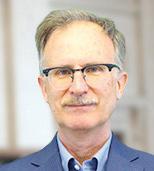
NHAMMOND Viewpoint
ew Yorkers continue to face some of the costliest health-insurance premiums in the U.S., and the insurance industry’s recently finalized rate applications shed light on why that is. In summaries filed with the state regulators, insurers attributed their price hikes to rising costs — including state-specific factors, such as insurance taxes and coverage mandates, as well as broad national trends, such as surging hospital and drug claims. These and other forces have pushed New York’s premiums to the top of the national price range.
According to a federal survey of employer-sponsored insurance, the Empire State’s businesses and consumers paid an average of $9,589 for single coverage in 2024, which was the highest in the country and $1,100 or 13 percent above the national average.
New York was also No. 1 for employee-plus-one coverage, with an average cost of $19,431, and No. 5 for family coverage, at $27,188.
Those averages are likely to continue climbing. In early September, the state Department of Financial Services announced higher-than-inflation premium increases for plans covering some 900,000 New Yorkers, or about one-eighth of the commercial market.
DFS approved premium hikes averaging 7 percent for individuals directly purchasing coverage and 13 percent for small employers. Those hikes were 2.4 times and 4.5 times the inflation rate, respectively. (Premiums for most companies with 100 or more employees are not subject to
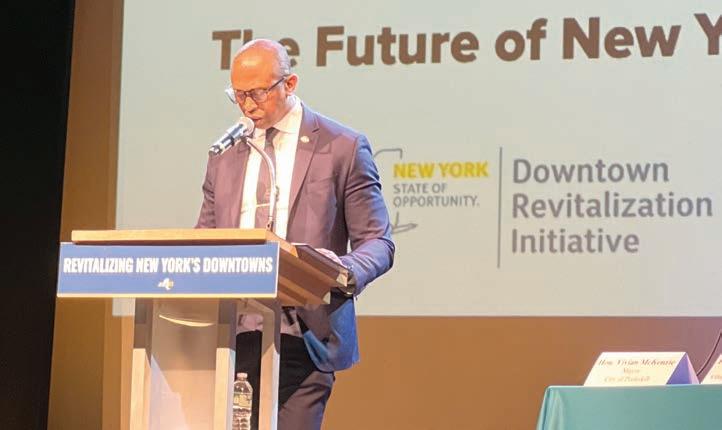
The Downtown Revitalization Initiative was launched in 2016 to accelerate and bolster the revitalization of downtowns and neighborhoods in all 10 regions of the state to serve as centers of activity and catalysts for increased local investments.
First announced as part of the 2022 budget, Hochul created the NY Forward program to build on the momentum created by the DRI. The program, which is funded at $100 million in this year’s enacted state budget, supports a more equitable downtown recovery for New York’s smaller and rural communities with a focus on hamlets and villages, the state says. n
state regulation.)
Although premiums in the regulated categories will be going up by about $1 billion, DFS headlined its news release with a claim that it had “saved” consumers $959 million. This is because insurers initially asked for even larger hikes, which the department cut roughly in half.
The cost drivers cited in rate applications varied from plan to plan, but certain themes emerged.
The major factor mentioned by most companies was surging claims — a combination of an aging customer base needing more medical care, and hospitals and doctors charging higher prices for their services.
For example, New York City–based Healthfirst said its hospital and physician claims were up 10 percent and its prescription-drug claims were up 16 percent.
Other plans mentioned federal-policy shifts, especially the looming expiration of enhanced Affordable Care Act (ACA) tax credits. The enhanced credits, enacted during the pandemic, reduced the net cost of coverage purchased by individuals through ACA insurance exchanges — which has encouraged more people to sign up. If they expire as scheduled on Dec. 31, enrollment in the ACA market is expected to decline — especially among healthier people with less need for coverage — which will result in a sicker risk pool and higher costs for the remaining buyers.
These trends help to explain why premiums are rising nationwide. Other factors cited in the regulatory filings are unique to New York — and therefore explain why its premiums are costlier than in other states.
One such issue is taxes on health insurance, which are unusually heavy in New York — and which were itemized in a
filing by the insurer Anthem:
• A surcharge of 9.63 percent on hospital services levied under the Health Care Reform Act of 1996.
• A “covered lives assessment,” also levied under the 1996 law, which varies from $3.52 to $15.93 per insurance customer per month.
• A premium tax of 1.75 percent on all HMO and insurance contracts, with an additional amount for customers in the Metropolitan Transportation Authority service region.
• A “206” assessment, which was intended to cover the costs of state regulatory activities, but which has been partly diverted to other expenses.
Rochester–based Excellus estimated in its filing that these taxes, taken together, add 5 percent to the cost of health coverage statewide. That would amount to about $500 for individual coverage or $1,400 for family coverage.
Not mentioned in this list is New York’s newly enacted tax on managed-care organizations, or MCOs. Although this tax falls most heavily on Medicaid plans as a strategy for maximizing federal matching funds, it also applies to commercial coverage at a rate of $1.50 to $2 per member per month.
The MCO tax took effect in January, but federal officials have since moved to cancel its approval — meaning it’s likely to expire in the months ahead.
Another state-specific factor cited by some health plans is coverage mandates.
These are laws requiring insurers to pay for certain services regardless of whether plans consider them to be medically necessary — or to limit or eliminate cost-sharing for certain types of claims.
MVP Health Plan attributed 0.1 points of its 8 percent requested rate hike to newly imposed mandates, but did not specify which ones.
A 2003 study commissioned by the Employer Alliance for Affordable Health Care estimated that mandates in force at the time added 12.2 percent to the cost of insurance — and the New York Legislature has enacted dozens more since then.
In 2024 alone, the legislature passed — and Gov. Kathy Hochul signed — laws requiring insurers to pay for prenatal vitamins, to cover the cost of scalp cooling (to prevent hair loss during cancer treatment), and to cap copayments for EpiPens (an emergency treatment for allergic reactions).
Among the mandates approved by the legislature in 2025 — and awaiting the governor’s signature — include bills that would require insurers to cover creative-arts therapy services, to cover speech therapy for stuttering, and to provide a minimum number of inhalers for asthma patients without cost-sharing. While not the only cause of New York’s high health premiums, state-imposed
1. SUNY Upstate Medical University
750 E. Adams St. Syracuse, NY 13210 (315) 464-5540/upstate.edu
2. Cornell University 410 Thurston Ave. Ithaca, NY 14850 (607) 255-2000/cornell.edu
3. Northeast Grocery, Inc. 461 Nott St. Schenectady, NY 12308 (518) 355-5000
4. Walmart 6438 Basile Rowe East Syracuse, NY 13057 (315) 434-9873/walmart.com
5. Wegmans Food Markets, Inc. 1500 Brooks Ave. Rochester, NY 14603 1-800-WEGMANS/wegmans.com
6. Syracuse University 900 S. Crouse Ave. Syracuse, NY 13244 (315) 443-1870/syracuse.edu
7. Lockheed Martin 1801 State Route 17C Owego, NY 13827 (607) 751-2200/lockheedmartin.com
8. Centralus Health 767 Warren Road Ithaca, NY 14850 (607) 274-4498
9. Turning Stone Enterprises 2037 Dreamcatcher Plaza Oneida, NY 13421 (315) 829-8900/ turningstoneenterprises.com
5,175NAa 114-store supermarket chain with stores in New York, Pennsylvania, New Jersey, Virginia, Maryland, Massachusetts, Delaware, North Carolina, Connecticut, and Washington, D.C.
Rochester Colleen Wegman, CEO1916
5,134$1.4Bprivate, coeducational, and residential university dedicated to higher education and research same Syracuse Kent Syverud, Chancellor & President 1870
5,100$71.3Bprovides systems engineering, software development, and complex program management for global security, civil, and commercial markets
Lockheed Martin Corporation Bethesda, MD
A. Hamid Salim, Owego GM1957
5,093NA health care IthacaMartin Stallone, CEO (until Nov. 7, 2025) Rob Lawlis, CEO (effective Nov. 7, 2025) Ronette Wiley , COO 2025
5,000NATurning Stone Resort Casino, YBR Casino & Sports Book, Point Place Casino, The Lake House at Sylvan Beach, The Cove at Sylvan Beach, Oneida Technical Solutions LLC, Oneida Innovations Group, Maple Leaf Markets, SavOn Convenience Stores, Salmon Acres, Oneida Indian Nation Outfitters, Verona Collective.
Oneida Indian Nation Oneida Ray Halbritter, Oneida Indian Nation Representative & CEO of Turning Stone Enterprises NA
10. St. Joseph's Health 301 Prospect Ave. Syracuse, NY 13203 (315) 448-5111/sjhsyr.org 4,000NA hospital and health-care system Trinity Health Livonia, MI Steven Hanks, President & CEO Meredith Price, SVP of Operations 1869
11.
United Health Services (UHS) 10-42 Mitchell Ave. Binghamton, NY 13903 607-762-2200/nyuhs.org
12. Mohawk Valley Health System (MVHS) 111 Hospital Drive Utica, NY 13502 (315) 917-9966/mvhealthsystem.org
SUNY Oswego 7060 State Route 104 Oswego, NY 13126 (315) 312-2500/oswego.edu
14. KPH Healthcare Services, Inc. (Kinney Drugs) 520 East Main St. Gouverneur, NY 13642 (315) 287-3600/kinneydrugs.com
15. National Grid 300 Erie Blvd. West Syracuse, NY 13202 NA/nationalgridus.com
Crouse Health 736 Irving Ave. Syracuse, NY 13210 (315) 470-7111/crouse.org
17. Guthrie Lourdes Hospital 169 Riverside Drive Binghamton, NY 13905 (607) 798-5111/guthrie.org/locations/ guthrie-lourdes-hospital
18. The Raymond Corporation, TMHNA 22 S. Canal St. Greene, NY 13778 (607) 656-2311/raymondcorp.com
19. Samaritan Medical Center 830 Washington St. Watertown, NY 13601 (315) 785-4000/samaritanhealth.com
3,971NA health-care provider same Binghamton
3,600NAhealth system providing medical care to mainly Oneida, Herkimer, and Madison counties and operating a new hospital in downtown Utica
John Carrigg, President & CEO1981
Stromstad, President & CEO 2014
Utica
3,525$221.3M higher-education institution State University of New York Albany Peter O. Nwosu, President1861
3,500NAretail pharmacy & health-care services, long-term care pharmacy, specialty pharmacy, pharmacybenefits management & mail-order pharmacy
3,200NAdelivering energy to nearly 600,000 customers across a 13-county Central NY region
3,100NA integrated health-care delivery system
Gouverneur David Warner , President & CEO 1903
Grid plc London, England
Syracuse
3,000NA health-care provider Guthrie Clinic Sayre, PA
2,800NAglobal provider of electric lift trucks, intralogistics solutions, intelligent warehouse solutions including telematics, energy solutions, automation and virtualreality education
Industries Corp. Greene (Chenango County)
Regional Director of Customer and External Affairs 1929
Kronenberg, President & CEO 1887
Sabanegh, President & CEO 1925
Wood, President & CEO Michael Field, COO
Research by Vance Marriner vmarriner@cnybj.com (315) 579-3911 @cnybjresearch
Upcoming Lists
October 20 Commercial Builders & Contractors
Oc tober 27
Web-Design Companies
1. Business Journal estimate
2,784NAacute inpatient care, outpatient clinics, cancer treatment, wound care, multi-specialty practice, surgical services, ED, maternity, long-term care, assisted living, rehabilitation and home-health care
2,500NAlong-term care, short-term rehabilitation, home and community-based services and senior housing for older adults in CNY
H. Carman, President & CEO 1881 20. Loretto 700 E. Brighton Ave. Syracuse, NY 13205 (315) 413-3269/lorettocny.org
Syracuse
Kimberly Townsend, President & CEO Julie Sheedy, Chief Marketing & Engagement Officer 1926 21. Binghamton University P.O. Box 6000 Binghamton, NY 13902 (607) 777-2000/binghamton.edu
Upstate Caring Partners 125 Business Park Drive Utica, NY 13502 (315) 724-6907/upstatecp.org 1,700$113M
D'Alleva, President1946
DeCondo, Executive Director 1950 23. Oneida Health 321 Genesee St. Oneida, NY 13421 (315) 363-6000/oneidahealth.org 1,600NAprimary, quickcare, specialty, rehabilitation, and hospital
Information was provided by representatives of listed organizations and their websites. Other groups may have been eligible but did not respond to our requests for information. While The Business Journal strives to print accurate information, it is not possible to independently verify all data submitted. We reserve the right to edit entries or delete categories for space considerations. Central New York includes Broome, Cayuga, Chemung, Chenango, Cortland, Herkimer, Jefferson, Lewis, Madison, Oneida, Onondaga, Oswego, St. Lawrence, Seneca, Tioga, and Tompkins counties.
WANT TO BE ON THE LIST?
& CEO1936
Syracuse Healthcare System 800 Irving Ave. Syracuse, NY 13210 (315) 425-4400/syracuse.va.gov 1,550NA health-care provider for veteransDept. of Veterans Affairs Washington, DC Michael DelDuca, Interim Medical Center Director 1953 25. Excellus BlueCross BlueShield 333 Butternut Drive Syracuse, NY 13214 (315) 671-6400/ExcellusBCBS.com 1,500$6.5B
If your company would like to be considered for next year’s list, or another list, please email: vmarriner@cnybj.com
The Central New York
BUSINESS JOURNAL
Digital I Print I Events I Data
OCTOBER 13, 2025
VOL. XXXVIII, NO. 36
NEWS
EDITOR-IN-CHIEF
Adam Rombel arombel@cnybj.com
STAFF WRITER
Eric Reinhardt ereinhardt@cnybj.com
CREATIVE DIRECTOR
Erin Zehr ewebb@cnybj.com
RESEARCH DIRECTOR
Vance Marriner vmarriner@cnybj.com
COLUMNISTS
William Barclay
Russell Gloor
Lee Hamilton
Bill Hammond
John C. Williams
SALES
Kelly Bailey kbailey@cnybj.com
CIRCULATION
CIRCULATION MANAGER
Raviv Nesher (315) 579-3927 circulation@cnybj.com
ADMINISTRATIVE
PUBLISHER
Marny Nesher mnesher@cnybj.com
OFFICE MANAGER
Patty Martino officemanager@cnybj.com
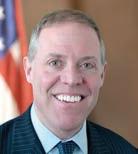
New York’s prison system is broken, and changes recommended by the New York State Department of Corrections and Community Supervision (DOCCS) to address some of its biggest shortcomings represent a great start to repairing that broken system. But until the Humane Alternatives to Long-Term Solitary Confinement (HALT) Act, which drastically limits correctional officers’ ability to isolate dangerous prisoners, is repealed, both prisoners and correctional facility staff will continue to be needlessly put in danger.
Considering the state of our prison system, I am encouraged by several of the recommendations included in the recently published DOCCS report. As I said earlier, these changes would restore some accountability and discipline where they were sorely lacking. Simply stated, violent criminals who are not forced to face the consequences of their actions pose a grave threat to our state’s correctional officers.
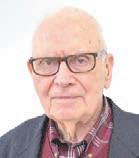
Congress created the United States Department of Defense in 1949 as part of a comprehensive effort to modernize the military and adapt to the international order that was taking shape after World War II. Now President Donald Trump wants to change its name to the Department of War, its former name. That’s a mistake, [I believe].
National defense is and should be the primary mission of our military. Projecting strength, working with our allies, and countering our adversaries through diplomacy has helped keep us safe and prosperous. That’s a legacy that we should affirm, not abandon.
Explicitly including ”sexual harassment and lewd conduct” and “patterns of extortion in connection with a gang or criminal enterprise” in the behaviors that make one eligible for segregated confinement are particularly noteworthy. Still, more must be done to protect and support New York state’s correctional officers, who, too often, are treated with less respect than they deserve, as well as the prisoners whom they oversee.
“It’s no secret recruitment and retention are major hurdles in the prison system.”
It’s no secret recruitment and retention are major hurdles in the prison system.
Even before Gov. Kathy Hochul fired 2,000 correctional officers who refused to work under the hazardous conditions created by HALT, staffing was a major concern. Prior to the terminations, there were just shy of 13,500 officers and sergeants working in state prisons despite a staffing plan calling for 14,600 officers and sergeants. These are alarming numbers, and we should be doing everything we can to support the brave men and women who work in these facilities, so we can ensure all our prisons are properly staffed and secure.
State correctional facilities and those involved in their operation are facing unprecedented challenges from Gov. Hochul’s administration. They have been for years. The constant threat of near-immediate closure for prisons in every region of the state, incessant drug smuggling, disciplinary limitations, and myriad other obstacles have contributed to dangerously low morale. We need to do things differently. The recommendations from DOCCS are a step in the right direction, and I am eager to continue working toward a better criminal-justice system. The Assembly Minority Conference knows that is the only way to keep all New Yorkers safe — prisoners, officers, and residents, alike. n
William (Will) A. Barclay, 56, Republican, is the New York Assembly minority leader and represents the 120th New York Assembly District, which encompasses all of Oswego County, as well as parts of Jefferson and Cayuga counties.
The Central New York Business Journal (ISSN #1050-3005) is published every week by CNY Business Review, Inc. All contents copyrighted 2025. All rights reserved. No part of this publication may be reproduced without the written consent of the publisher.
Cover Price $3.00
Subscription Rate $95 per year Call (315) 579-3927
When the Defense Department was established, the Soviet Union was expanding its influence rapidly, leading to the creation of NATO; the Soviets were about to detonate a nuclear bomb. Mao Zedong was declaring the People’s Republic of China. “It was a terrifying time for Americans,” David Sanger writes in the New York Times, “and the new name was intended to reflect an era in which deterrence was critical — because war, if it broke out among the superpowers, could be planet-ending.”
Deterrence, a key strategy for defense, was effective, and it remains critical. The Cold War ended, but Russia and China still threaten their neighbors. Instead of two nations with nuclear weapons, there are nine, and the weapons are more danger-
ous. Threats to the planet continue.
The Trump Administration has begun using the new [Department of War] name; but, ultimately, changing the Defense Department’s name is up to Congress. The legislative branch has shown an unfortunate tendency to defer to the president. This is a chance for it to assert its authority.
Trump likes the name War Department because it has “a stronger sound.” It evokes an era when the United States “won everything,” by which he means two world wars. He signed an executive order declaring that the department should be called the Department of War and its leader, Pete Hegseth, would be the secretary of war.
But the department’s history is not straightforward. Congress established the War Department in 1789. A few years later, it created a separate Navy Department. For much of American history, the Army and Navy were administered separately, causing rivalries. Creating the Defense Department with civilian leadership brought greater coordination.
Renaming the Defense Department can be seen as an exercise in branding — the idea that you can increase the value of a product or property by giving it a new name. It sends a message, like declaring the Gulf of Mexico is the Gulf of America and restoring the names of Confederate generals to military bases. It aligns with Trump’s America First philosophy and his disdain for soft power exercised through diplomacy and engagement. It suggests we’ve grown less committed to practicing defense.
It also plays in the hands of Russia
and China, which portray America as an aggressive power that other nations shouldn’t trust. Trump’s executive order says the U.S. will “wage war to secure what is ours.” Some countries will take that as a threat.
The name War Department may have nostalgic appeal, hearkening back to an era before the frustrations of our military entanglements in Korea, Vietnam, Iraq, and Afghanistan. We are right to celebrate our military victories in World War I and World War II and to take pride in America’s crucial role in those conflicts. But we shouldn’t ignore that those wars were incredibly costly, causing tens of millions of deaths.
There’s an aphorism attributed to Sun Tzu, the legendary Chinese military strategist: The best battle, he wrote, is the one that you don’t have to fight. By that standard, the Defense Department has done its job well. Yes, America must be prepared to fight wars if necessary. But it’s much better to use our military strength and the power of our defense to prevent wars that aren’t necessary. n
Lee Hamilton, 94, is a senior advisor for the Indiana University (IU) Center on Representative Government, distinguished scholar at the IU Hamilton Lugar School of Global and International Studies, and professor of practice at the IU O’Neill School of Public and Environmental Affairs. Hamilton, a Democrat, was a member of the U.S. House of Representatives for 34 years (1965-1999), representing a district in south-central Indiana.a
OCTOBER 15
n Battery Week event: Southern Tier Manufacturing Solutions Forum from 9:30 a.m.-3 p.m. at SUNY Broome Culinary Center. Industry leaders, manufacturers, and economicdevelopment partners will come together to explore the opportunities and resources available in New York state’s growing battery and energy-storage sector. The day features presentations from manufacturers already making the transition, insights into workforce training, access to research and state incentives and collaborative discussions designed to help companies expand into this high-growth supply chain. Open to companies, but free registration is required. For more information and to register, visit: https://neny.org/battery-week-2025/
OCTOBER 16
n Salvation Army 54th Annual Civic Celebration from 12-1:30 p.m. at the Oncenter - Nicholas J. Pirro Convention Center, 800 S. State St., Syracuse. The Civic Celebration is an opportunity to shine a light on those who have supported the Salvation Army of Syracuse throughout the year, those who have made a significant impact on the community, and those who have sought help through the diverse programs of the organization. This year’s guest speaker is Jeanette Epps, a proud Syracuse native and trailblazing NASA astronaut. For more information and to register, visit: https://easternusa.salvationarmy.org/empire/ syracuse/54th-annual-civic-celebration/
OCTOBER 17
n Vera House 2025 New Beginnings Gala from 6-10 p.m. at the Oncenter in downtown Syracuse. This signature event brings together neighbors, friends, and local leaders to honor the strength of survivors of domestic and
Email event listings to: calendar@cnybj.com
sexual violence and to raise vital funds for Vera House’s 24-hour crisis line, emergency shelter, counseling services, and prevention programs. For more information and to register, visit: https://www.verahouse.org/2025-newbeginnings-gala
OCTOBER 21
n 25th Annual Hoops for Hope Dinner with Syracuse men’s basketball from 5:30-8:30 p.m. at the at the Oncenter - Nicholas J. Pirro Convention Center, 800 S. State St., Syracuse. This is a unique early season opportunity to meet head coach Adrian Autry, his staff, and the 2025-2026 Syracuse men’s basketball team. All proceeds benefit about 1,000 youth, ages 5 to 18, participating in programs offered at three safe Clubhouses and two gymnasiums in Syracuse neighborhoods with the lowest household incomes and highest rates of crime. For more information and to register, visit: https://secure.givelively.org/event/boys-girlsclub-of-syracuse/25th-annual-hoops-for-hopedinner-w-su-men-s-basketball
n Downtown Committee of Syracuse 2025 Fall Progress Breakfast from 8-9:30 a.m. at the Marriott Syracuse Downtown, 100 E. Onondaga St., Syracuse. The 2025 Fall Progress Breakfast will highlight the vision and collaboration driving downtown Syracuse’s evolution. At this event, you will have the opportunity to hear from speakers who will deliver captivating presentations about the transformation and revitalization of downtown Syracuse. This engaging event will highlight the various elements that come together to create a truly remarkable downtown. Doors open at 8 a.m., program runs from 8:15-9:15 a.m., followed by networking. For more information and to register, visit: https://www.downtownsyracuse. com/events/signature/fall-progress-breakfast
power to control.
If they want health coverage to be more affordable and accessible, Gov. Hochul and other elected officials should look to roll back or repeal insurance taxes and mandates instead of continually adding
n Syracuse Go Red for Women from 10:30 a.m.-1:30 p.m. at the Oncenter - Nicholas J. Pirro Convention Center Ballroom, 800 S. State St., Syracuse. Go Red for Women is dedicated to connecting women to motivate each other, educate each other, and inspire each other. United, we have the power to build communities that foster better health. Festival of Red runs from 10:30-11:45 a.m., luncheon & program is from 12-1:30 p.m. For more information and to register, visit: https://ahasyracuse.ejoinme.org/ ents/20252026SyracuseGoRedforWomen/ tabid/1524769/Default.aspx
OCTOBER 29
n Economic Champions Celebration from 11 a.m.-1:30 p.m. at the Oncenter Nicholas J. Pirro Convention Center, 800 South State St., Syracuse. CenterState CEO’s Economic Champions event honors the outstanding businesses and organizations that are contributing to the growth of the Central New York economy. Through new jobs, new business ventures, expansions and investments, DEI commitments, company milestones and more, they are part of the team that is driving the region’s progress. From startups to well-established businesses, this collective success takes champions at every level, and CenterState CEO will recognize their outstanding achievements and impact. For more information and to register, visit: https:// centerstateceo.com/events/10/2025/economicchampions-celebration
n 2025 Dannible & McKee Tax & Financial Planning Conference from 2-5:30 p.m. at Drumlins, 800 Nottingham Road, Syracuse. The conference offers timely tax and financial insights and professional education. This year, Dannible has reimagined the format to fit
Bill Hammond is senior fellow for health policy at the Empire Center for Public Policy, which says it is an independent, nonpartisan, nonprofit think tank located in Albany that promotes public-policy reforms grounded in free-market principles, person-






attendees’ busy schedule while keeping the high-value content and connections of past events. For much more information on what the conference entails, visit: https://www. cnybj.com/event/2025-tax-financial-planningconference/. To register, visit the event website: https://www.dmcpas.com/events/2025-taxfinancial-planning-conference/
n 40 Under Forty Awards program from 5-8 p.m. at the Oncenter in downtown Syracuse. This awards event recognizes 40 ambitious, hard-working, civic-minded individuals, who are under the age of 40. These individuals have excelled in the workplace and in the community. Come celebrate these young professionals who are making a difference in our community. This year’s event will feature: networking and cocktail hour, reserved sit-down seating for dinner, the awards celebration, and more. For more information and to register, visit: https://www. cnybj.com/event/40-under-forty-awards/
14
n AFP-CNY National Philanthropy Day
Breakfast from 8:30-10:30 a.m. at DoubleTree by Hilton Hotel – Syracuse, 6301 State Route 298 in the town of DeWitt. National Philanthropy Day is a special day to recognize and pay tribute to the meaningful contributions that philanthropy — and those active in our own philanthropic community — makes to our lives, communities, and world. This year, APF-CNY will unite with chapters nationwide and globally to commemorate National Philanthropy Day 2025. It will honor individuals, organizations, and businesses in Central New York who selflessly contribute their time, talents, and resources to enrich and benefit our communities. For more information and to register, visit: https://community.afpglobal.org/ afpnycentralchapter/events/npd
al responsibility, and the ideals of effective and accountable government. Hammond tracks developments in New York’s healthcare industry, with a focus on how decisions made in Albany and Washington, D.C. affect the well-being of patients, providers, taxpayers, and the state’s economy.

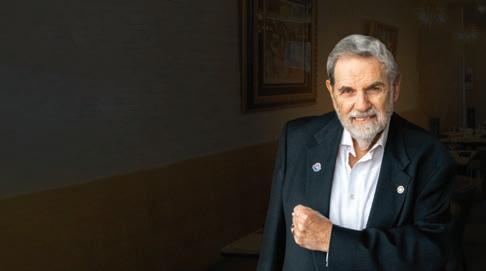

SPONSORED CONTENT
Editor’s note: Submit your People on the Move news at https://www.cnybj.com/submit/people/
Hancock Estabrook, LLP announced that real-estate attorney EMILY J. AZIZ has joined the law firm as an associate. She will work in Hancock Estabrook’s real estate department and represents clients in a broad range of commercial real-estate matters. That includes the negotiation and drafting of commercial leases and purchase and sale agreements, as well as the review of titles, surveys, and other due-diligence materials. Aziz also advises clients on residential real-estate transactions and has experience counseling cooperative and condominium boards on governance, compliance, and day-to-day operational is-

sues. She earned her law degree from the Syracuse University College of Law, where she served as executive editor of the Journal of Science and Technology. Aziz received a bachelor’s degree from Hobart and William Smith Colleges. She is admitted to practice in New York state.

The South Side Community Growth Foundation has appointed DEKA (DANCIL) EYSAMAN as its inaugural executive director. A lifelong Syracuse resident, Eysaman is recognized for her leadership in advancing equity and opportunity. Most recently, she served as assistant director of field organizing at

NERIK MICHAL Viewpoint
ecessity is famously the mother of invention. With uncertainty surrounding marketing budgets big and small, the current need for business-to-business (B2B) marketers is almost universal: the ability to accurately measure return on investment (ROI), justifying every line-item to the penny. Here’s a wide-angle look at the trends shaping the quest for more accurate ROI measurement.
Looking at a campaign broadly from start to finish, which elements are driving people to your website? Can you identify which element played a role in which sale by getting a customer to our website? Answering those questions is key to accurately determining ROI.
A marketing-automation platform (MAP) or customer-relationship management (CRM) platform is uniquely positioned to collect the following data on an individual level:
•Paid-media impressions/clicks
Continued from page 4
expectations. This principle has become a bedrock of modern central banking, as economic analysis and history have shown that anchoring inflation expectations is important in maintaining low and stable inflation.
Well-anchored inflation expectations short-circuit so-called second-round effects in wage and price setting that exacerbate and prolong the impacts of the kinds of shocks we saw during the 1970s. They also create a more favorable short-run
the New York Civil Liberties Union. Also, as board president of the Urban Jobs Task Force, Eysaman led the “I-81 Local Hire” campaign, securing 15 percent local jobs for the viaduct project and millions in wages for the community. Eysaman also brings extensive experience in youth development, having served with the Boys & Girls Clubs of Syracuse and Syracuse University’s Science and Technology Entry Program. In 2020, she was honored by BizEventz and CNYBJ as a 40 Under Forty recipient. As executive director, Eysaman will guide the foundation in strengthening its impact, deepening community connections, and advancing a shared vision for Syracuse’s South Side.
JAKE SANDLER has joined JF Real Estate
•Landing-page sessions/engagement/ engagement time
•Form starts and completions
•Email-open rates and click-through rates
•Final-sale conversions, values, and contributors
The broader idea behind collecting and analyzing each of these data points is to relate a specific conversion or sale by an individual to the steps that led to that sale. While there are opportunities to include traditional marketing methods such as television, billboards, and even word-ofmouth marketing to assess their value, this article will focus on less nuanced data from your digital platforms.
Drilling down even further: If the purpose of cross-channel marketing is to get users to your website and volunteer their contact information, how effective is each element of your website toward achieving that goal?
In the quest to identify where ROI is lagging, you will identify bottlenecks in your sales process. A poor marketing strategy can act like a dam in a river. If one tactic becomes a barrier for leads, it could dry up every other tactic that follows. When that happens, it’s hard to assess any one tactic’s value. If potential leads are stalling at the same step along the path to conversion, you might have identified a clog in the sales funnel.
trade-off in achieving inflation and employment objectives.
Central banks help anchor expectations by owning the responsibility to deliver price stability, publicly committing to an explicit inflation target, and taking the actions needed to ensure price stability. The connections between policy communications and actions, inflation outcomes, and expectations are at the core of robust policy strategies.
Unlike the stylized textbook model of monetary policy, a robust policy approach recognizes that the economy is changing and uncertain. It also views the anchoring of expectations, or the
Start with your website. Which pages on your website are generating the most page views and engagement time? Which videos are visitors spending the most time watching? Which assets are they downloading most often?
Tracking the customer journey through your website can generate other useful data points. Knowing what product page a customer viewed gives you an idea about the specific solution/service they’re looking for, a relative idea of their budget for a solution, and what timeframe they might be working with to find a solution.
To the latter point: because B2B conversions require more time than business to consumer (B2C), patience is key. You might have run a campaign a long time ago and forgotten about it, yet that campaign resulted in a recent big sale. This can significantly alter that campaign’s ROI. Longer sales cycles also mean you need to hold attention longer. Politely nurturing leads allows your brand to stay top of mind — don’t let them forget about you and your value.
MAPs, CRMs, SEO, Meta, LinkedIn, and whatever solution you’re using for display ads all yield actionable data. Tying it together is a challenge. A data analyst can help analyze the data and bring it all together in a way that adds practical value.
A good analyst will be able to communicate, in terms of an understandable story,
lack thereof, as the outcome of monetary policy actions and communications, not an assumed fact.
I have talked about the importance of three key principles: ownership of price stability and independence of action, transparency about goals and strategy, and a focus on anchored inflation expectations. But like that family of black bears on the Snake River, the unexpected is always waiting around the bend. These principles and lessons provide a strong foundation for monetary policy that prepares us for the unexpected challenges and uncertain-
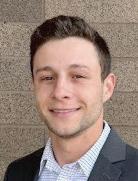
as a real-estate salesperson. He received his bachelor’s degree in communications and media studies from Washington College, and spent six years as the assistant coach for the men’s and women’s tennis teams at Colgate University, where he honed his leadership, strategy, and team-building skills. With a passion for relationship-building and a commitment to excellence, Sandler is looking forward to bringing a disciplined, service-driven approach to every real-estate opportunity. He will also be serving an administrative role for Partnership Properties, the management company for many of the buildings exclusively represented by JF Real Estate. n
what the data is telling you. That story should fit a recognizable template — for example, “here’s how customers, clients, and leads are interacting with your brand,” or “this is what your potential customers want from you.” The analyst can also tell you what tactics you pay for but perform poorly, effectively hamstringing your marketing budget and costing time as well. This can also potentially remove an impediment to getting the maximum ROI.
“A poor marketing strategy can act like a dam in a river. If one tactic becomes a barrier for leads, it could dry up every other tactic that follows.”
The strength of the story the data paints isn’t merely dependent on the quality of your analyst — it’s dependent on the blind spots of the data itself. Unless you have all the pieces in one place, and they can talk to each other, maximizing your ROI will be impossible. Worse yet, if key data points are missing or left unconsidered, it might heavily skew your conclusions in a false direction.
Wrangling all the disparate data points generated by any marketing campaign to determine ROI can be a challenge — one of the largest challenges that cuts across industries today. However, it’s worth the effort. With the correct tools and personnel, measuring ROI can help yield insights that will make your next campaign more successful than your last. n
Erik Michal provides email and marketing automation leadership for ddm marketing + communications, a B2B digital-marketing agency for highly complex and highly regulated industries.
ties we face ahead. n
John C. Williams is president and CEO of the Federal Reserve Bank of New York. This article is drawn (and edited for space) from a speech, as prepared for delivery, that he gave on Oct. 3 at the Klaas Knot Farewell Symposium, at De Nederlandsche Bank (DNB) in Amsterdam, Netherlands. In his speech, Williams gave the standard Fed disclaimer that the views he expressed were his alone and do not necessarily reflect those of the FOMC or others in the Federal Reserve System. The full, unedited text of the speech is available at: https://www.newyorkfed. org/newsevents/speeches/2025/wil251003
PRESENTED BY


Alanna Abreu UHY Advisory, Inc.
Celestin Abwe Clutch Delivery LLC
Matthew Baisley Oneida County
Jamie Bova FustCharles
Cassandra Bulak Loretto
Lamar Chamblee NBT Bank
Kevin Conway
Caruso McLean Investment Advisors
Meghan Crawford-Hamlin BHG Financial
Tracy DiGenova Office of Gov. Kathy Hochul
Gideon Dixon M&T Bank
Kimber Doolittle Pinckney Hugo Group
Courtney Gauthier KeyBank
Kirsten Gosch
Cayuga Museum of History & Art
Emily Gozy
Nourished with Emily, LLC
Kara Jones CenterState CEO
Nitch Jones
SUNY Upstate Medical University
Shaun Kaleta Oneida County
Chelsey Lavere
Turning Stone Resort Casino
Liza Magley
Bond, Schoeneck & King PLLC
Matthew Malinowski
Syracuse Police Department
Jennifer Marshall
Griffiss Institute
Ryan McCarthy
Rejuvn8 Aesthetics
Colleen McLaughlin
McDonald’s
Sara Mowers
Excellus BlueCross Blueshield
Emily Middlebrook
Hancock Estabrook, LLP
Emily Minnoe
Francis House
Jessica Montgomery
Stay Fresh, LLC
Diana Nightingale
David’s Refuge
Ryan O’Donnell Chimera Integrations
Lorna Oppedisano
Onondaga Historical Association
Jeffrey Pawlowski in-Architects, PLLC
Vinny Peone
Eastern Security Services
Christine Petrone Dannible & McKee, LLP
Audrey Piccione
Arc Herkimer
Jonathan Schneckenburger Thompson & Johnson Equipment Co., Inc.
Lauren Usherwood
Usherwood Office Technology
Joseph Viviano
Ascension Wealth Management
Bridget Volz
Onondaga County Health Department
Ryan Woodruff
Clear Path for Veterans
Corin Zimmer
Luck Grove